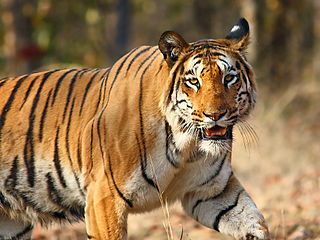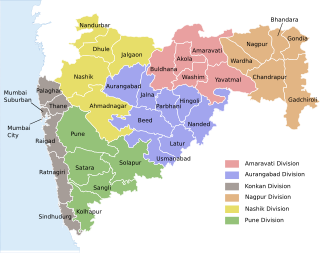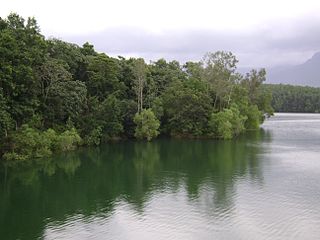
Thane district is a district in the Konkan Division of Maharashtra, India. At the 2011 Census it was the most populated district in the country, with 11,060,148 inhabitants; however, in August 2014 the district was split into two with the creation of a new Palghar district, leaving the reduced Thane district with a 2011 Census population of 11,060,148. The headquarters of the district is the city of Thane. Other major cities in the district are Navi Mumbai, Kalyan-Dombivli, Mira-Bhayander, Bhiwandi, Ulhasnagar, Ambarnath, Badlapur, Murbad and Shahapur.

Sanjay Gandhi National Park is an 87 km2 (34 sq mi) protected area in Mumbai, Maharashtra. It was established in 1969 with its headquarters situated at Borivali.

Nagzira National Park is a wildlife sanctuary is situated in Tirora, Arjuni (Sadak) & Goregaon Tahsils of Gondia District and Sakoli, Bhandara, Lakhni Tahsil of Bhandara district. The closest National Highway is NH-53. The Nagzira Wildlife Sanctuary has many fish species, 34 species of mammals, 166 species of birds, 36 species of reptiles, and four species of amphibians. The invertebrate fauna includes a number of butterfly and other insect species. Large wild mammals present here include the Bengal tiger, Indian leopard, gaur, sambar, nilgai, chital, wild boar, sloth bear, Indian muntjac, Indian spotted chevrotain and dhole. There is also an Indian elephant named Rupa. Nearly 30,000 tourists visit this sanctuary annually.
Bhimashankar Wildlife Sanctuary was created in the Ambegaon and Khed talukas of Pune District, in the Western Indian state of Maharashtra in order mainly to protect the habitat of the Indian Giant Squirrel.

The word Maharashtra, the land of the mainly Marathi-speaking people, appears to be derived from Maharashtri, an old form of Prakrit. Some believe that the word indicates that it was the land of the Mahars and the Rattas, while others consider it to be a corruption of the term 'Maha Kantara', a synonym for 'Dandakaranya'. Maharashtra is the third largest state in India after Rajasthan and Madhya Pradesh. It covers an area of 307,713 km2 and is bordered by the states of Madhya Pradesh to the north, Chhattisgarh to the east, Telangana to the southeast, Karnataka to the south and Goa to the southwest. The state of Gujarat lies to the northwest, with the Union territory of Dadra and Nagar Haveli sandwiched between the borders. Maharashtra has coastline of 720 km.The Arabian Sea makes up Maharashtra's west coast. Maharashtra consists of two major relief divisions. The plateau is a part of the Deccan tableland and the Konkan coastal strip abutting on the Arabian Sea.
Radhanagari Wildlife Sanctuary is a wildlife sanctuary and natural World Heritage Site of category ix and x since 2012, located in Kolhapur district, Maharashtra State, India. It lies at the southern end of the Sahyadri hills in the Western Ghats. It is notable as the first declared wildlife sanctuary in Maharashtra, notified in 1958, as "Dajipur Wildlife Sanctuary" and is popularly known as the "Bison Sanctuary". Indian bison or gaur with a population around 1091 in 2014, is the flagship species of the area. It was notified as Radhanagari wildlife sanctuary vide notification No. WLP/1085/CR/588/ V/F-5, Dt.16.9.1985. The area around the Sanctuary was declared as Eco sensitive zone by Govt. of India on 15 October 2020
Khardi is a town in the Thane district, of Maharashtra. It is also a station on the Mumbai Suburban Railway system on the Central line route between Kalyan and Kasara.

The Peppara Wildlife Sanctuary is a wildlife sanctuary in Thiruvananthapuram district of Kerala, India. It consists of the catchment area of the Karamana River, which originates from Chemmunjimottai, the tallest hill within the sanctuary. The sanctuary is named after the Peppara Dam, commissioned in 1983 to augment the drinking water supply to Thiruvananthapuram city and suburban areas. Considering the ecological significance of the area, it was declared a sanctuary in 1983. The terrain is undulating with elevation ranging from 100 m to 1717 m. The area of the sanctuary is 75 km2 with tropical moist evergreen forests and myristica swamps. It is part of the Agasthyamala Biosphere Reserve. Peppara Wildlife Sanctuary is 44 kilometres (27 mi) by car from the nearest railway station, at Thiruvananthapuram, and 49 kilometres (30 mi) from the Thiruvananthapuram airport.
Govind Pashu Vihar National Park and Wildlife Sanctuary is a national park in Supin Range, near Uttarkashi town in the district and state of the same name in India. It was established initially as a wildlife sanctuary in 1955, and was later converted into a national park. It is named after prominent Indian freedom fighter and politician Govind Ballabh Pant, who became Home Minister in 1955 and is credited for establishing Hindi as an official language of India.
Gautala Autramghat Sanctuary is a protected area of Maharashtra state, India. It lies in the Satmala and Ajantha hill ranges of the Western Ghats, and administratively is in Aurangabad District and Jalgaon District. The wildlife sanctuary was established in 1986 in an existing reserved forest area.

Vanashakti is a non-profit environmental NGO based in Mumbai, Maharashtra. It was formed in 2006, by Meenakshi Menon, Namita Roy Ghose, and Peter Armand Menon. Vanashakti aims to conserve the forests, wetlands, wildlife corridors, habitats, through education and litigation to achieve its objectives of creating awareness about environmental topics, protecting and reviving rivers and preventing opencast mining in areas that are well-endowed with biodiversity. It also directs its efforts in involving local forest-dwelling communities to protect the biodiversity of the region and provides sustainable livelihood options for forest dependent and coastal communities. Vanashakti's thrust areas are forest, mangrove and wetland protection, environmental education for both urban and rural schools, livelihoods for forest based communities and scientific investigation into local environmental degradation.

Palghar District is a district in the state of Maharashtra in Konkan Division. The headquarters of the district is the town of Palghar. Other major cities in the district are Vasai-Virar, Talasari, Jawhar and Dahanu.
Bhiwandi taluka is a taluka in Thane district of Maharashtra in Konkan division. It contains the city of Bhiwandi.
Thane taluka is a taluka in Thane district of Maharashtra state in Konkan division.
Ulhasnagar taluka is a taluka in Thane district of Maharashtra in Konkan division.
Shahapur taluka is a taluka in Thane district of Maharashtra in Konkan division.
Karanja Sohol Wildlife Sanctuary is a protected area in the Karanja talukas of Washim district in Maharashtra, India. It was created in 2000 to preserve the black buck population. It covers 1,832 ha (18.32 km2) of forest and grasslands.
The Lona Wildlife Sanctuary is situated around a lagoon called Lonar Lake, which was created by a meteorite impact about 50,000 years ago. The diameter of the Lonar lake is 1.83 km. This sanctuary located in Lonar taluka of Buldhana district of Maharashtra. The sanctuary is spread over an area of 365.16 Hectares. It includes the 77.69 Ha Lonar lake. The forest around the lake is mainly Southern Tropical dry Deciduous Forest. In 2020 the Lonar lake was declared as Ramsar site. The foul smell of hydrogen sulfide gas is common near the lake water.
The AnerDam Wildlife Sanctuary is located in Shirpur talukas of Dhule district, India. The sanctuary is spread over southwestern side of Satpura hill ranges. This sanctuary is spread around the catchment area of Aner river specially above the high flood level around the Aner Dam. This sanctuary has common boundary with Yawal Wildlife Sanctuary in Jalgaon district and forest area of Khargone district in Madhyapradesh.
The Yedshi Ramling Ghat Wildlife Sanctuary is located in Osmanabad district. Yedshi Ramling Sanctuary has headquarters at Yedshi. It is situated 20 km from Osmanabad city and 95 km from Beed city. The Latur-Barshi highway passes through the sanctuary. The sanctuary is situated in Kalamb, Bhansgaon and Wadgaon villages of Osmanabad and Kalamb Tehsil of Osmanabad district. It is situated in the Balaghat mountain range of the Sahyadri. In 1997, the government declared an area of 2237.5 hectares as 'Ramling Ghat' Sanctuary for the protection of various plants, animals and birds. It is also known as hill station as it is high above sea level.








